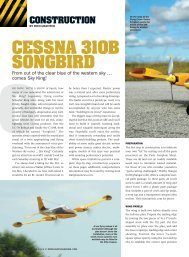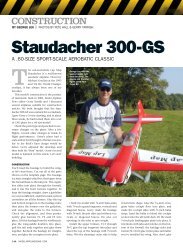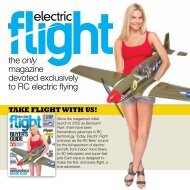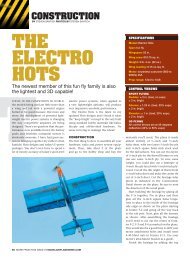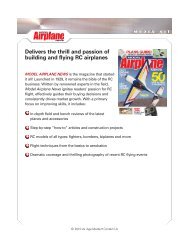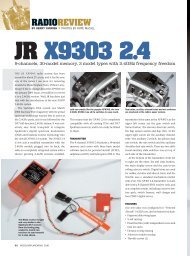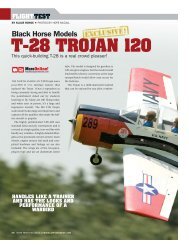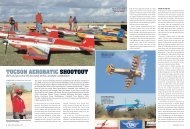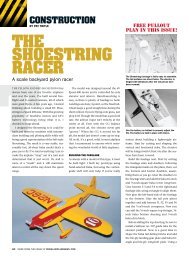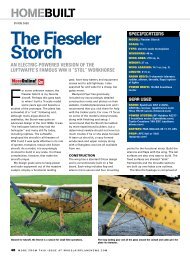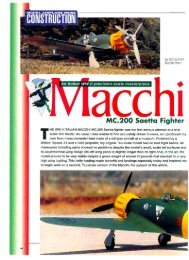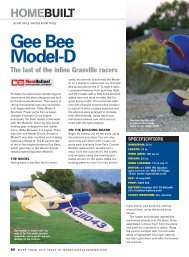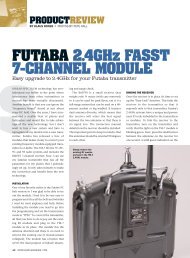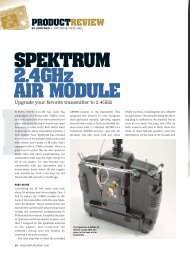You also want an ePaper? Increase the reach of your titles
YUMPU automatically turns print PDFs into web optimized ePapers that Google loves.
FMA DIRECT CD-PILDT<br />
on a scale of from one to 10 what the IR<br />
conditions are. Between three and 10<br />
deflections means the unit will operate<br />
properly; two indicates that the unit will<br />
operate but needs its sensitivity increased<br />
over cooler terrain. If the unit deflects only<br />
once, it means there isn't enough difference<br />
in the IR temperature between sky and<br />
ground. It's best not to fly with the unit<br />
turned on.<br />
After step one, the servos begin to cycle<br />
slowly. During this time, you must place<br />
the model on the ground in a level flight<br />
attitude and then walk away about 10<br />
feet. The unit then calibrates itself for<br />
level flight. Once the unit is calibrated, all<br />
you have to do before each successive<br />
flight for the rest of the day is to quickly<br />
check that the unit is working. Turn on<br />
the transmitter and receiver, and point<br />
the model's nose toward the ground. The<br />
unit should provide full up-elevator. Also,<br />
when you point a wingtip at the ground,<br />
it should deflect either the rudder or the<br />
ailerons (depending on which channel<br />
you have the unit plugged into) to correct<br />
the bank angle. After this quick check,<br />
you can launch the model.<br />
Fun Scale<br />
Boeing PT-17 Stearman<br />
Span 89"<br />
Length<br />
Weight<br />
Power<br />
(scale 1:4.3)<br />
69"<br />
18-21 Ib<br />
180+ 4 strokes<br />
(2 stroke petrol or glow equally acceptable)<br />
Radio 4 channel, 5 servos<br />
Flair Products Ltd<br />
www. flairproducts. co. uk<br />
Available in the US at:<br />
Radical RC<br />
7046 Harshmanville Road,<br />
Huber Heights, Ohio 45424<br />
Web: www.radicalrc.com.<br />
Email: DAVTHACKER@aol.com<br />
GCBM R/C Inc.<br />
5009 Fairdale.<br />
Pasadena. TX 77505,<br />
Order line: 800-609-7951.<br />
Fax: 281-998-2529.<br />
Web: www.gcbmrc.com.<br />
Email: mlmcgraw@pdq.net<br />
AUTOPILOT FLIGHT<br />
The day I tested the unit, I installed it in a<br />
Multiplex Brummi and flew it on a windy<br />
day. From the moment I hand-launched<br />
the model, the unit worked beautifully. As<br />
is normal, to climb, I held up-elevator and<br />
applied full power. When the model was<br />
about 75 feet high, I let go of the control<br />
stick and waited to see what would happen.<br />
The Brummi tracked straight into the wind,<br />
and its wings always returned to level—<br />
even after a strong gust of wind tipped the<br />
wing nearly vertical. After it flew to the<br />
edge of the field, I turned the model to the<br />
right (slightly downwind) and let go of the<br />
controls again. As before, the model righted<br />
itself whenever necessary and maintained a<br />
constant altitude. During the flight, I even<br />
crabbed the model into the wind; it happily<br />
flew slightly sideways as the wind pushed it<br />
along. The wind became rather strong at<br />
this point, so I throttled it back and guided<br />
the model straight into the wind for a landing.<br />
The Co-Pilot kept its wings level all the<br />
way to the flare; all I did was adjust the<br />
throttle to control the descent.<br />
On the second flight, I turned the sensitivity<br />
down about 1/4 turn and had an<br />
even nicer flight. This time, the wind<br />
Magnattila<br />
Span 60"<br />
Engines .30-.40 2 str.<br />
.40-.60 4 str.<br />
Radio 4 channel<br />
Weight 5.5 Ibs^,<br />
FLAIR<br />
Texan/Harvard<br />
Span: 66"<br />
Weight: 5 - 7 Ib<br />
Radio: 4 Channel<br />
Engines: .30 - .46 2 str<br />
.40 - .60 4 str<br />
Sport Aerobatic<br />
Fabulous Builders Kits,<br />
(33 models in range)<br />
Authentic Vintage Kits,<br />
(36 models in range)<br />
Quality ARTF Kits,<br />
(25 models in range)<br />
and Accessories for all needs.<br />
Dealer enquires welcome<br />
Visit our website to see comprehensive details.<br />
76 MDDEL AIRPLANE NEWS<br />
by Hal deBolt<br />
This radical new Co-Pilot stabilization system<br />
reminds me of the first adventures I had with<br />
reed and proportional RC systems. You have to<br />
do two things to make the unit operate properly.<br />
First, be sure that the neutral points on the<br />
model's control surface are properly set before<br />
you install the unit. Then, after completing the<br />
Co-Pilot preflight checkout, you must make sure<br />
that the control settings haven't changed. With<br />
or without the Co-Pilot online, they should be<br />
the same.<br />
The hook-and-loop-fastening material that<br />
came with the unit was a little too spongy for my<br />
taste. It could be compressed and then not<br />
return to its original condition. This lack of con-<br />
sistency made it easy to disturb the sensor,<br />
which caused an alignment problem. Using<br />
either a thinner fastener material or double-<br />
sided servo tape to attach the sensor would<br />
eliminate this problem. The ideal location for the<br />
sensor is out on a wing panel, away from things<br />
that can affect the sensor's view. It is possible<br />
to mount it on the fuselage, but you must make<br />
sure that the landing gear and/or the propeller<br />
do not affect the unit's operation. To properly<br />
control the model, you will have to fly the model<br />
with the unit activated to see if it needs any<br />
fine-tuning. I found that a solidly mounted sen-<br />
sor was difficult to adjust, so I made a simple,<br />
adjustable sensor mount with a ball-link attach-<br />
ment on the fuselage. It is a plywood plate<br />
attached to a ball swivel, which permits infinite<br />
movements. Two adjustment screws allow fine-<br />
position adjustment of the entire sensor unit.<br />
This adaptation worked just fine.<br />
AUTOGYRO APPLICATION<br />
Gyros and helicopters require constant control<br />
attention; a loss of orientation and control close<br />
to earth can be disastrous. It isn't unusual for a<br />
gyro to attain a nose-up attitude without the<br />
pilot noticing the change. I have seen gyros get<br />
to very high altitudes and then drift for a 1/2 mile<br />
downwind because the model's attitude wasn't<br />
apparent to its pilot. If this happens to someone<br />
who is using the Co-Pilot, the system will stabi-<br />
lize the model until orientation is regained. The<br />
Co-Pilot works so well that I have also seen it<br />
control a perfect landing for a gyro that was<br />
practically out of sight. The gyro was hovered at<br />
a high altitude and when the model's power was<br />
reduced, it produced a proper descent that<br />
ended in a no-rollout landing.<br />
On all types of models-fixed-wing, heli-<br />
copters and autogyros-l can say that the<br />
FMA Co-Pilot stabilization system works as<br />
advertised!



